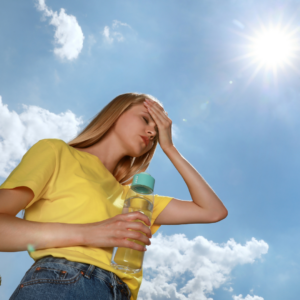 By Kathy Hubbard
By Kathy Hubbard
“I was stupid! It was 94 degrees, the water was like glass, and I wanted to go kayaking. I kayaked for three hours and felt great until I stood up! Everything went spinning. I got cold, felt as though I needed to vomit, and couldn’t think straight.” The 55-plus-year-old woman who wrote this for MedicineNet.com didn’t explain why she thought she was stupid.
My best guess would be that she neglected to drink enough water prior to and during strenuous exercise in the heat. And, she probably didn’t protect her head or body from the sun’s rays. Oh yeah, that’d be it. She was lucky in that she most likely only suffered from heat exhaustion and that it didn’t progress to heat stroke, which can be fatal.
With weeks of hot weather behind us, we need to make sure we don’t become complacent about taking precautions. I know that we’re going to cram in all the hiking, biking, kayaking, swimming, and jet skiing we can before summer is over. And, I’ll be the last one to tell you to stay indoors when it’s hot outside. You just need to remember to take some precautions. The first of which is to avoid dehydration.
Remember, when you feel thirsty, you’re already dehydrated. So always take along a bottle of water when you’re out getting exercise. Avoid alcohol and caffeine. That means no coffee, no beer, no tea, no caffeinated soft drinks, no Coke and rum, and no chocolate milk!
Wear lightweight, light-colored, loose-fitting clothes. Don’t forget to wear a hat or your helmet if the sport recommends one or a hard hat if you’re working construction in the heat of the day. Take breaks more often and replenish lost electrolytes with sports drinks if you perspire a lot.
Hyperthermia (an abnormally high body temperature) can occur indoors. Keep the shades drawn against the afternoon sun, open the windows to get a cross breeze, and turn on a fan or two to circulate the air. Never, ever leave a child, pet, or yourself in a closed vehicle.
“The body cools itself by sweating and allowing that sweat to evaporate. This requires enough fluid in the body to make sweat, air circulating across the skin, and low enough air humidity to allow that sweat to evaporate,” explains MedicineNet.com.
“Activity in a hot environment can overwhelm the body’s ability to cool itself, causing heat-related symptoms. Symptoms of heat exhaustion include profuse sweating, weakness, nausea, vomiting, headache, lightheadedness, and muscle cramps.
“Heat exhaustion can progress to heat stroke when the body’s temperature regulation fails. The affected individual develops a change in mental status, becomes confused and lethargic, and may have a seizure, the skin stops sweating, and the body temperature may exceed 106 F (41 C ).
This is a life-threatening condition, and emergency medical attention is needed immediately.”
This is important to know: victims of heat stroke must receive immediate treatment to avoid permanent organ damage. You must figure out a way to cool the victim. That’s right after you call 911.
“Get the victim to a shady area, remove clothing, apply cool or tepid water to the skin (for example, you may spray the person with cool water from a garden hose), fan the victim to promote sweating and evaporation, and place ice packs under the armpits and groin,” MedicineNet.com says.
The Centers for Disease Control says to give fluids to a victim of heat exhaustion, but not to one with suspected heat stroke. Since you probably don’t carry a thermometer around with you, look for hot red dry, or moist skin and a rapid and strong pulse. If so, the person most likely has heat stroke.
Regardless of whether it’s heat stroke or heat exhaustion, it’s important to take it easy for a few days. Our kayaker stated that she suffered migraine-like headaches for a week afterward. Oh yeah, then she got back on the water.
Kathy Hubbard is a member of the Bonner General Health Foundation Advisory Committee. She can be reached at [email protected]. This article was written for and published in the Bonner County Daily Bee on August 24, 2022.
